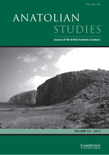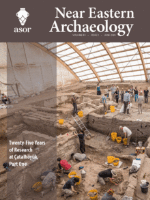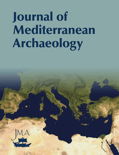
Adalya
Scope & Guideline
Connecting Scholars to the Heart of Mediterranean Studies
Introduction
Aims and Scopes
- Archaeological Studies:
The journal consistently publishes articles that delve into archaeological findings, excavations, and artifacts, emphasizing their historical significance and contributions to understanding ancient societies. - Cultural and Historical Analysis:
Research focused on cultural continuity, transformation, and interactions among civilizations, particularly in the context of Anatolia, the Mediterranean, and the Near East, is a prominent theme. - Art and Material Culture:
The exploration of artistic expressions, including sculptures, inscriptions, and pottery, is a critical area, highlighting their roles in social and cultural contexts. - Epigraphy and Inscriptions:
The journal features significant contributions on inscriptions, seals, and other epigraphic materials, providing insights into ancient languages, societies, and their administrative practices. - Architectural History:
Studies on historical architecture, urban planning, and public spaces, particularly during different historical periods, form a substantial part of the journal's content.
Trending and Emerging
- Interdisciplinary Approaches:
There is a growing trend towards interdisciplinary research that incorporates methodologies from various fields such as anthropology, art history, and archaeology, enriching the understanding of cultural phenomena. - Digital Archaeology and Technology:
Emerging topics related to the use of technology in archaeology, such as digital mapping and analysis of artifacts, are gaining traction, reflecting the influence of technological advancements in research methodologies. - Cultural Heritage and Preservation:
An increasing focus on cultural heritage, preservation practices, and the implications of archaeological findings for contemporary society is evident, highlighting the relevance of historical research in modern contexts. - Local Histories and Case Studies:
Recent articles emphasize localized historical narratives and case studies that provide in-depth insights into specific regions, enhancing the understanding of broader historical trends.
Declining or Waning
- Byzantine Studies:
Research specifically focused on the Byzantine period has become less frequent, indicating a potential shift in emphasis toward earlier or later historical contexts. - Trade and Economic Relations:
While trade relations were previously a significant area of study, recent issues show a decline in publications addressing economic interactions, particularly during the Hellenistic and Roman periods. - Ottoman Studies:
Articles specifically addressing the Ottoman Empire, particularly its market regulations and inspections, have seen a decrease, suggesting a potential shift towards earlier historical periods.
Similar Journals

BULLETIN MONUMENTAL
Cultivating Insights in Architectural Preservation.BULLETIN MONUMENTAL, published by the Société Française d'Archéologie Musée Monument Français, stands as a pivotal journal in the field of archaeology and architectural history. With its ISSN of 0007-473X, this journal features a rich compilation of research and insights dedicated to the preservation and study of France's monumental heritage. Although it is not currently open access, its contributions are critical for scholars, professionals, and students interested in the intersection of history, culture, and preservation practices. Covering a continuous period from 2002 to 2016, the journal has played an essential role in documenting advancements in archaeological methodology and conservation efforts, making it an invaluable resource in its field. Researchers seeking to deepen their understanding of architectural monuments in France will find BULLETIN MONUMENTAL a vital source of scholarly articles and field studies.

Anatolian Studies
Advancing Knowledge in Archaeology and Cultural StudiesAnatolian Studies, published by Cambridge University Press, stands as a premier forum for research in the fields of archaeology, cultural studies, and history. Established in 1951, this esteemed journal has consistently contributed to the academic discourse surrounding the rich and multifaceted history of Anatolia, earning its place in the Q1 category across multiple disciplines. With a notable impact factor reflected in its Scopus rankings, it ranks among the top journals in its fields: 78th in History, 155th in Cultural Studies, and 55th in Archaeology, showcasing its significant influence and recognition. This journal serves as an invaluable resource for researchers and scholars seeking to delve into the intricacies of Anatolian heritage, providing a platform for innovative research and critical discussion within the academic community. While it currently does not offer open access, Anatolian Studies continues to enrich scholarly resources and advance knowledge within its key areas of focus.

NEAR EASTERN ARCHAEOLOGY
Bridging Past and Present Through Archaeological InquiryNEAR EASTERN ARCHAEOLOGY, published by University of Chicago Press, is a premier journal dedicated to the field of archaeology, particularly focusing on the rich cultural heritage and archaeological findings of the Near East. With an ISSN of 1094-2076 and an E-ISSN of 2325-5404, this esteemed publication provides a vital platform for scholars and practitioners to share their research, insights, and discoveries. The journal holds an impressive ranking in the Q1 quartile for both Archaeology and History in 2023, reflecting its significant impact within these fields and a robust history of scholarly contribution. The journal has been pivotal in shaping discussions around archaeological methodology, theory, and contemporary issues from 2002 to 2024, as it continues to reach a wide audience through various access options. With Scopus rankings placing it in the top percentiles for both History and Archaeology, NEAR EASTERN ARCHAEOLOGY represents an essential resource for researchers, professionals, and students alike, fostering the exploration and understanding of the region's archaeological narrative.

Journal of Mediterranean Archaeology
Fostering Dialogue on Mediterranean Archaeological InsightsThe Journal of Mediterranean Archaeology, published by EQUINOX PUBLISHING LTD in the United Kingdom, is a premier academic journal dedicated to the exploration and dissemination of knowledge within the vibrant field of Mediterranean archaeology. Established in 1988, this journal has consistently demonstrated its commitment to scholarly excellence, attaining a Q1 ranking in various categories, including Archaeology and Arts and Humanities, making it a vital resource for researchers and students alike. With a prominent Scopus rank of #49 out of 413 in Archaeology, it places itself among the top-tier publications, reflecting its impact and relevance in contemporary archaeological discourse. Although the journal is not open access, its rigorous peer-review process ensures the publication of high-quality scholarly articles that contribute significantly to the understanding of the diverse cultural narratives within the Mediterranean region. As the journal moves toward its 35th anniversary, it continues to be a cornerstone for professionals seeking to share groundbreaking research and dialogue in this critically important area of study.

Spal
Innovating Insights into Our Shared Heritage.Spal is a distinguished academic journal dedicated to the fields of Archaeology and History, published by the University of Seville, Editorial. With an ISSN of 1133-4525 and an E-ISSN of 2255-3924, it has established a prominent reputation within the scholarly community, currently enjoying an impressive Q1 ranking in Archeology (Arts and Humanities) and History, alongside a Q2 ranking in Archeology for 2023. The journal serves as a critical platform for researchers, professionals, and students alike, promoting the dissemination of cutting-edge research and innovative methodologies in these vital disciplines. Spal's Scopus Ranks place it in the 84th percentile for Arts and Humanities - History and the 72nd for Archeology within the field, emphasizing its impact and relevance in contemporary scholarship. Although it operates under a traditional access model, its commitment to advancing knowledge and discourse in archaeological and historical studies remains unwavering. The journal's coverage spans from 2015 to 2024, positioning it well to contribute to ongoing academic conversations and foster collaborations within the global research community.

Anadolu Arastirmalari-Anatolian Research
Connecting Scholars through Interdisciplinary ResearchAnadolu Arastirmalari-Anatolian Research, published by ISTANBUL UNIVERSITY, is a prominent open-access journal dedicated to the exploration of history, archaeology, and related fields. Since its transition to open access in 2017, the journal has become a vital resource for scholars and practitioners, facilitating the dissemination of innovative research findings. With a strong focus on the intricacies of Anatolian history and archaeology, the journal has earned notable recognition, achieving a Q1 ranking in History and Q2 rankings in both Archaeology and Arts and Humanities categories as of 2023. This positions it among the foremost journals in its field, providing an essential platform for interdisciplinary research and discourse. The journal's impact factor is evidenced by its significant citation metrics and rigorous editorial standards, aiming to contribute meaningfully to scholarly dialogue and knowledge production. Researchers, professionals, and students alike will find this journal indispensable for understanding the rich tapestry of Anatolian culture and heritage.

Deltion of the Christian Archaeological Society
Unearthing Stories: The Intersection of Archaeology and SpiritualityDeltion of the Christian Archaeological Society (ISSN: 1105-5758, E-ISSN: 2241-2190), published by the Christian Archaeological Society in Athens, Greece, stands as a pivotal source of scholarly work within the realm of Christian archaeology. This journal is dedicated to disseminating high-quality research that promotes the understanding of Christian history, heritage, and archaeological practices. Though it operates under traditional access options, it provides a comprehensive platform for researchers and professionals alike, fostering dialogue and collaboration within the archaeological community. With a commitment to advancing knowledge, the Deltion aims to support both established scholars and emerging voices, reinforcing the significance of archaeology in interpreting religious narratives and cultural contexts. Researchers, students, and professionals interested in the intersections of archaeology, history, and theology will find this journal an invaluable resource in their scholarly pursuits.

Aula Orientalis
Fostering Dialogue in Archaeology and HistoryAula Orientalis, an esteemed academic journal published by the Universitat de Barcelona's Institute of Ancient Near Eastern Studies, serves as a vital platform for scholarly discourse in the field of Near Eastern Archaeology, History, and Philology. With an ISSN of 0212-5730, this journal aims to disseminate high-quality research, fostering a deeper understanding of the ancient Near East through the publication of articles, reviews, and discussions by leading experts and emerging scholars alike. Although the journal has undergone changes in its indexing status, it continues to maintain a focus on rigorous academic standards and relevance in the global research community. Positioned at the crossroads of history and archaeology, Aula Orientalis encourages interdisciplinary collaboration and is ideal for researchers, professionals, and students seeking to expand their knowledge and engage with contemporary issues in ancient studies.

Ancient Asia-Journal of the Society of South Asian Archaeology
Connecting Scholars to the Wonders of Ancient AsiaAncient Asia - Journal of the Society of South Asian Archaeology, published by ARF India, stands as a pivotal resource for the exploration and dissemination of archaeological research focused on the rich history and culture of South Asia. Since its inception as an Open Access journal in 2006, it has become an essential platform for scholars and enthusiasts alike, boasting an impressive range of quartile rankings across multiple disciplines, including Anthropology, Archaeology, History, and Visual Arts. With expansion into various indexed categories and consistent dissemination of impactful research common to this highly diverse field, Ancient Asia aims to foster interdisciplinary dialogue, facilitate collaboration among researchers, and enhance the global understanding of ancient civilizations within the region. By embracing an inclusive access model, the journal encourages wide readership and engagement, positioning itself as a key player for students, professionals, and academics interested in delving into the archaeological marvels of South Asia.

Zeitschrift fur Assyriologie und Vorderasiatische Archaologie
Illuminating the Rich Tapestry of Near Eastern ArchaeologyZeitschrift für Assyriologie und Vorderasiatische Archäologie, published by WALTER DE GRUYTER GMBH, is a distinguished journal in the field of archaeology, focusing on the rich histories of the ancient Near East and Assyrian studies. Established in 1886, this journal has a venerable tradition of contributing to scholarly discourse, continuously curating impactful research that positions it within the Q2 quartile in the domains of Archaeology and Arts and Humanities as of 2023. With an impressive ranking of #101 out of 413 in Arts and Humanities and #98 out of 354 in Social Sciences within Scopus, the journal serves as a vital resource for researchers, professionals, and students alike. Although it operates under a subscription model, the journal's extensive coverage—from its inception to the present day—ensures a comprehensive exploration of archaeological methodologies, discoveries, and theoretical frameworks. The journal's aim is to advance the understanding of the ancient civilizations of the Near East and to foster scholarly communication across international platforms, making it an essential venue for contemporary archaeological research.